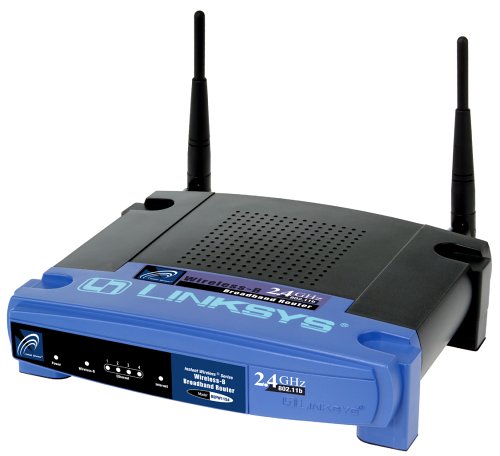Cisco-Linksys BEFW11S4 Wireless-B Cable/DSL Router Review
Special Prices: Check Special Prices now!
Cisco-Linksys BEFW11S4 Wireless-B Cable/DSL Router Overview
The Linksys BEFW11S4 is your all-in-one networking device This wireless router features support for the 802.11b protocol, which lets you wirelessly access your network and the Internet from up to 800 feet (outside), or 300 feet (inside) awayCisco-Linksys BEFW11S4 Wireless-B Cable/DSL Router Specifications
In the past, people creating a home network had to choose between string ing cheap Ethernet cable all over the house or spending tons of cash on a slow, unreliable wireless system. Products like the BEFW11S4 wireless four-port cable/ DSL router from Linksys have changed all that. This unit works as an Internet ga teway, traditional four-port Ethernet hub, and wireless Ethernet hub; is easy to install; and is relatively inexpensive. With the Linksys cable modem and wireless Ethernet adapter we tested with the unit, everything worked like a charm with next to no configuration hassles.The BEFW11S4 is chunkier than a standard Ethernet switched hub, but is so versatile that a little extra bulk is acceptable. Basic installation involves little more than plugging in the power cord and connecting the Ethernet output from your cable or DSL modem to an input port on the back of the device. Four Ethernet ports on the back accept connections from computers with standard network interface cards, while two antennas on the back handle the unit's wireless capabilities. The standard ports operate at up to 100 Mbps, while the 802.11b technology allows for wireless transmissions at up to 11 Mbps. That's not the blazing-fast performance you'd get from more expensive 802.11a or 802.11g wireless products, butis more than enough to handle Internet connection sharing, LAN gaming, and normal file transfer duties.
This product's forte is Internet connection sharing, as it serves as a single point of contact for every computer attached to a home network. All your ISP sees is one IP address sending and receiving Internet traffic, even though several computers on the other side of the BEFW11S4 might be accessing the Internet at the same time. The other nice thing about this setup, as opposed to standard Internet connection-sharing software, is that no particular PC must be turned on before the others on the network can access the Internet. As long as the BEFW11S4 is running, any PC can get on the Web.
Although the device is surprisingly easy to set up, a Web-based interface is available that lets advanced users access security settings, permissions, and a variety of other options. It is easy to use and can be accessed by any PC on the network without having to install special software. The unit itself provides plenty of feedback, as it is equipped with several LEDs that indicate the status of each standard connection, along with the wireless signal. There also is an uplink port on the back that lets users add more hubs, switches, or other devices as their network grows.
The router performed as expected in tests, providing fast 100 Mbps speeds to two basement computers using the standard Ethernet ports and a steady 11 Mbps signal to a third PC located upstairs and about 40 feet laterally from the base transmitter. The strength of the wireless signal is entirely dependent on the conditions in which the device is used, but most home users shouldn't have a problem reaching any one room of their house from any other room.
Perhaps the only drawback to the BEFW11S4 is that if installation doesn't go as smoothly as it did for us, configuring the device could be difficult for novice users. It's designed to be a plug-and-play unit, but there are hundreds of seriously advanced settings lurking under that friendly façade that can really mess things up if they are not configured properly. The good news is that most users likely won't have any problems, and once the BEFW11S4 is set up it works so smoothly and seamlessly that you'll forget it's there after a while. --T. Byrl Baker
Pros:
- Easy installation, seamless operation
- Makes it very easy to share an Internet connection
- Powerful configuration options for those who want to get their hands dirty
- Wireless Ethernet adapters to connect to a PC must be purchased separately
- 802.11b transmission speeds are pokey compared to more modern standards
For more information on the differences between an Access Point and a Router wit h Access Point, see the following table:

See a comparison diagram of the different wireless technologies. | Wireless networks are rapidly becoming more popular and coming down in price. Since they don't require cables, you can use the devices anywhere in an office or home, even out on the patio. There's no need to roll out an Ethernet network cable to each room of a house; you can network anywhere -- without wires. Outside of the home, wireless networking is available in hotspots at coffee shops, businesses, airports -- great when you're on the road and need to get some work done. For convenience, wireless networking is the answer. Basically, a standard is a set of specifications for a device. All devices that follow a specific standard share operating characteristics, such as the radio frequency used and maximum data transfer speed.
To learn about the differences between the standards and select the right one for your network, click here for an easy-to-understand chart. |
Cisco-Linksys BEFW11S4 Wireless-B Cable/DSL Router Feature
- Connects to a broadband modem, a 10/100 Ethernet backbone, or wireless network
- Long wireless operating range supports 300 feet indoors and 1,500 feet outdoors
- Provides roaming, best access-point selection, load balancing, and network traffic filtering
- Configurable through your networked PC's Web browser
- Can act as a DHCP server for your existing network
B00005ARK3ASIN
B00005ARK3Cisco-Linksys BEFW11S4 Wireless-B Cable/DSL RouterItem Brand
Cisco
Product Information and Prices Stored: Sep 06, 2012 21:15:45


No comments:
Post a Comment